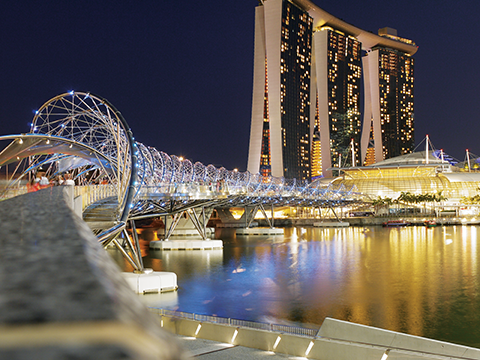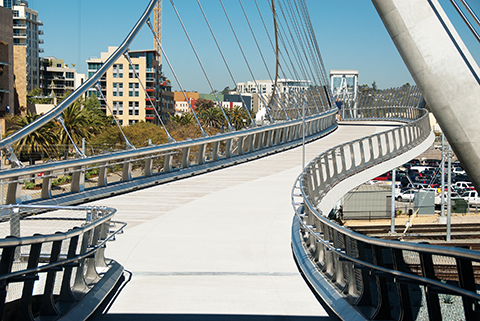
The Helix
Completed in 2010, the Helix Bridge, previously known as the Double Helix or DNA Bridge, is a new landmark linking Singapore’s Marina Centre with Marina South. The world’s first double-helix bridge is part of a high-profile development project and completes a 3.5-km (2.2-mi) pedestrian walkway around Marina Bay. The design consortium included architects COX Group Pte. (Australia), Architects 61 (Singapore), and the engineering firm Arup.
Two delicate helix duplex 2205 stainless steel structures surround the walkway and act as a tubular truss to resist design loads. That same material was also used for the cantilevered viewing ‘pods’ that extend out from the bridge and the slender concrete-filled support columns. The high strength of the duplex stainless steel pipes made much lighter sections possible for a total bridge weight of 1700 tonnes (1873 tons). It is estimated a conventional box girder bridge would have used five times as much carbon or weathering steel. When maintenance painting and other costs were considered, the 100-year design life analysis showed 2205 was a lower cost option than carbon steel.
Harbor Drive Bridge
Opening in 2011, San Diego’s Harbor Drive Pedestrian Bridge is one of the longest self-anchored pedestrian bridges in the world. Designed to last at least a century, the elegantly simple lines of this horizontally curved structure mimic the look of the sailboats on the adjoining harbor.
The streamlined design is different from traditional suspension bridges, using a design that hides the main tension cables inside welded pipes. The main cable is enclosed within a 203-mm (8-in.) stainless steel pipe, and extends from the ground to the top of a single 40-m (131-ft) inclined pylon along the inside of the curve. Thirty-four suspender cables connect the inside edge of the curved deck to the main cable pipe. A second longitudinal post-tensioned cable is hidden inside the 203-mm stainless pipe above the inside railing and provides horizontal force to stabilize the bridge.
Designers chose high-strength corrosion-resistant duplex 2205 stainless steel because of the alloy’s strength and the site’s regular salt fog exposure and longevity requirements. The designers fully utilized the high strength of this alloy. Type 316 austenitic steel was used for the suspender cables and safety mesh. The connectors for the cable system are 2205.

New Middle East bridge
A spectacular new pedestrian bridge project is nearing completion in the Middle East. Taking full advantage of the unique characteristics of the specified materials, it consists of two cable-stayed bridges that repeatedly curve apart and then intersect, creating a graceful series of figure eights. The design concept was a necklace being draped along the ring of the island marina. The open areas between the curving bridges are glass-floored for evening activities. Each bridge is approximately 200 m (656 ft) long and spans 90 m (295 ft) over the water from one quay to the other.
As the Middle East coast is a corrosive environment, duplex 2205 stainless steel was used for all the visible steel structural elements, including the supports for the cantilevered glass floors and concrete decks, along with canopy structures and bridge balustrade posts. The bridge pylons are also clad in duplex 2205 plate, which is structural, offers corrosion protection, and applies compression to the pylons.
Conclusion
The high strength and corrosion resistance of duplex stainless steels make them suitable choices for building/construction structural applications including bridges, railings, glass support structures, and sunscreens where strength and corrosion resistance is important. The new AISC design guidance has made it much easier for North American firms to design with structural stainless steel.
Alloy specification guidance is available from articles, industry associations, and producers. In more corrosive locations, however, the assistance of an expert in stainless steel atmospheric corrosion should be obtained to verify appropriate alloy specification.
Catherine Houska, CSI, is a senior development manager at TMR Consulting. She is a metallurgical engineering consultant specializing in architectural metal specification, restoration, and failure analysis. Houska was a member of the steering committee for American Institute of Steel Construction (AISC) Steel Design Guide 27, Structural Stainless Steel, and has authored more than 160 publications, including several features for The Construction Specifier. She can be reached via e-mail at chouska@tmr-inc.com.





Very nice and well documented article.
Thank you
aga
It’s cool that they have newer and nicer designs for duplexes. It gives people a good option with lots of different design choices. Stainless steel is really nice to have inside a duplex, and will probably attract tenants.
Dolores, it’s a Stainless Steel duplex system, a type of steel, not a duplex apartment!
thanks admin to contribute us for a knowledgeable topic